Forages for Improving Saline Soils
- How Saline Soils Form
- Using Forages for Saline Soil Management
- Effective Practices for Reducing Saline Problems
- Forage Establishment
- Soil Fertility
- Saline Demonstration Plots
What is Salinity?
Saline soils are soils that contain high concentrations of soluble salts: sodium sulphate (Glauber's salts), magnesium sulphate (epsom salts), calcium sulphate (gypsum) and some sodium chloride (table salt), but have normal pH values.Saline soils are not to be confused with alkaline.Alkaline soils have low concentrations of soluble salts but are characterized by pH levels greater than 8.5. This high pH is caused by sodium (Na) ions attached to the clay particles.It is estimated that approximately 0.6 million acres throughout Manitoba are effected by saline soils, but true alkaline soils are very rare.
How Saline Soils Form
Saline soils from when excess water in the recharge area moves into the ground water and then flows laterally underground.As the ground water flows it dissolves and transports soluble salts which naturally occur in Manitoba's soil parent material. Eventually the ground water reaches a point where it hits an impermeable material and is forced to or close to the surface of the soil.This area is called the discharge area (Figure 1).When the water table is less than 1.5 meters from the soil surface the salt-laden water wicks to the surface through capillary action.At the surface the water evaporated and the salts are left behind; in extreme cases a white or grayish powder-like substance form on the soil surface.
Figure 1:Ground Water Flow and Soil Salinity
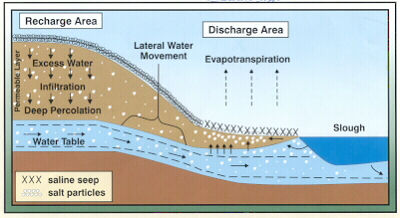
Ground water flows may be local, intermediate or regional. A local system has the recharge area within a few hundred meters of the discharge area. An intermediate system consists of several local systems interconnected with one another and usually spans over one kilometer. A regional system consists of a recharge area at the divide of a watershed and the discharge area at the bottom of the basin, therefore spanning over several kilometers.
Using Forages for Saline Soil Management
Although salinity will not disappear, effective water management can reduce or stop salts from reaching the soil surface where they inhibit pant growth. Practices should be implemented that reduce water from reaching the water table, intercept lateral water movement, or prevent water from reaching the soil surface (Figure 2).
Effective Practices for Reducing Saline Problems
- Plant deep-rooted perennial forages such as alfalfa in recharge areas to use large quantities of soil moisture thereby preventing excess water from moving into the water table.
- Plant deep-rooted perennial forages in a 20-60 m band before the discharge area. This band of forage will decrease the amount of water reaching the discharge area.
- Plant salt tolerant perennial forages in the saline area to intercept salt-laden water before it reaches the soil surface. Salts will be left below the rooting zone thereby improving the growing conditions for forages and crops.
Figure 2:Forage Placement for Reducing Saline Problems
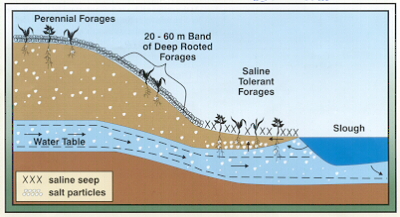
Forage Establishment
Forages should be established on saline land when the land is still capable of supporting barley, the most saline tolerant field crop. Seeding can occur in early spring, early summer, late August or early September depending on the likelihood of spring flooding. For successful winter survival, legumes must be seeded in the spring or early summer only. The seeding rate is double of that used on non-saline soils. Table 1 shows the tolerance of different plants to salts. In saline areas soil salinity concentration can vary widely even within a few meters. It would be worthwhile evaluating the field for degree and extent of the salinity problem. Combining a number of salt tolerant forages may be the best way to deal with a field with high variation.
Table 1:Relative Tolerance of Crops and Weeds to Salt
| Salt Tolerance Level | Forages | Speed of Forage Establishment | Weed/Crop |
|---|---|---|---|
| Very High | Tall Wheatgrass | Slow | Red Samphire |
| Very High | Beardless Wild-rye | Medium | Sea Blight |
| Very High | Slender Wheatgrass | Fast | |
| High | Altai Wild-rye | Slow | Kochia |
| High | Russian Wild-Rye | Slow | Foxtail Barley |
| High | Western Wheatgrass | Slow | |
| High | Tall Fescue | Fast | |
| Moderate | Alfalfa | Fast | Barley |
| Moderate | Sweetclover | Medium | Wheat |
| Moderate | Birdsfoot Trefoil | Slow | Fall Rye |
| Moderate | Bromegrass | Slow | Oats |
| Low Tolerance | Timothy | Flax | |
| Low Tolerance | Alsike Clover | Canola | |
| Low Tolerance | Red Clover | Corn | |
| Low Tolerance | Reed Canary Grass | Beans | |
| Low Tolerance | Sainfoin | Peas |
Soil Fertility
Saline soils are often lacking available nitrogen and phosphorous which hinders fast establishment and good plant growth. It is recommended that the area be to soil samples to determine if fertilizer is required. Forages with proper fertility will yield more and compete better with weeds.
Saline Demonstration Plots
In the Southwest region of Manitoba four saline demonstration plots were established between 1997 and 2000. These plots highlight forages known to have salinity tolerance. The include Ducks Unlimited saline mix , alfalfa, tall wheatgrass, western wheatgrass, slender wheatgrass, tall fescue, Russian wild rye, and beardless wild rye.The forages show different abilities to establish in saline areas and compete with weeds. In order of fastest to slowest establishing wee tall fescue, slender wheatgrass, alfalfa, Bucks Unlimited saline mix, tall wheatgrass, Russian wild rye, western wheatrass, and beardless wild rye.

Weed infestations were dominant in the slow establishing western wheatgrass and beardless wild rye plots. Many weeds such as the kochia, pictured below, are very saline tolerant and can hamper forage establishment. Weed control with herbicides or mowing improved forage stand establishment. While the plots are mostly single species plantings it may be advisable to mix a few species together to get quick establishment and stand longevity. Eastern wheatgrass and Russian wild rye are long-loved, alfalfa, tall fescue, tall wheatgrass are medium-lived; and slender wheatgrass and beardless wild rye are short-lived. The plots have show that it is best to establish forages before salinity and weeds become major problems; even well adapted forages have difficulty dealing with heavy weed infestation high salt concentrations.
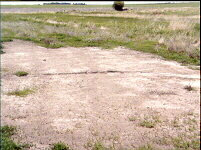
In this area of extreme saline conditions the ground is covered with white salt deposits. It is difficult to establish even salt tolerant forages once salinity is this concentrated. Forages should be established in a band around this area and in the recharge area if it can be located. This saline area will increase in size and severity if nothing is done.
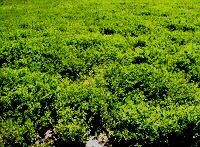
This alfalfa field has been established along the edge of a slough in a moderately saline area. Alfalfa has moderate salinity tolerance so it can be used in saline soils, but because of its deep-root system and high water use it is also an excellent forage to use in recharge and lateral water movement areas. Alfalfa is the most salt tolerant legume.
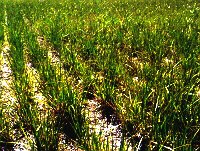
This stand of tall wheatgrass has the highest tolerance to salinity but due to it’s coarse and unpalatable nature it should not be used if livestock grazing is desired. However, it may be the only choice if the salinity concentration is too high for other forages. Once tall wheatgrass is established it will compete effectively with weeds like foxtail barley and kochia.
